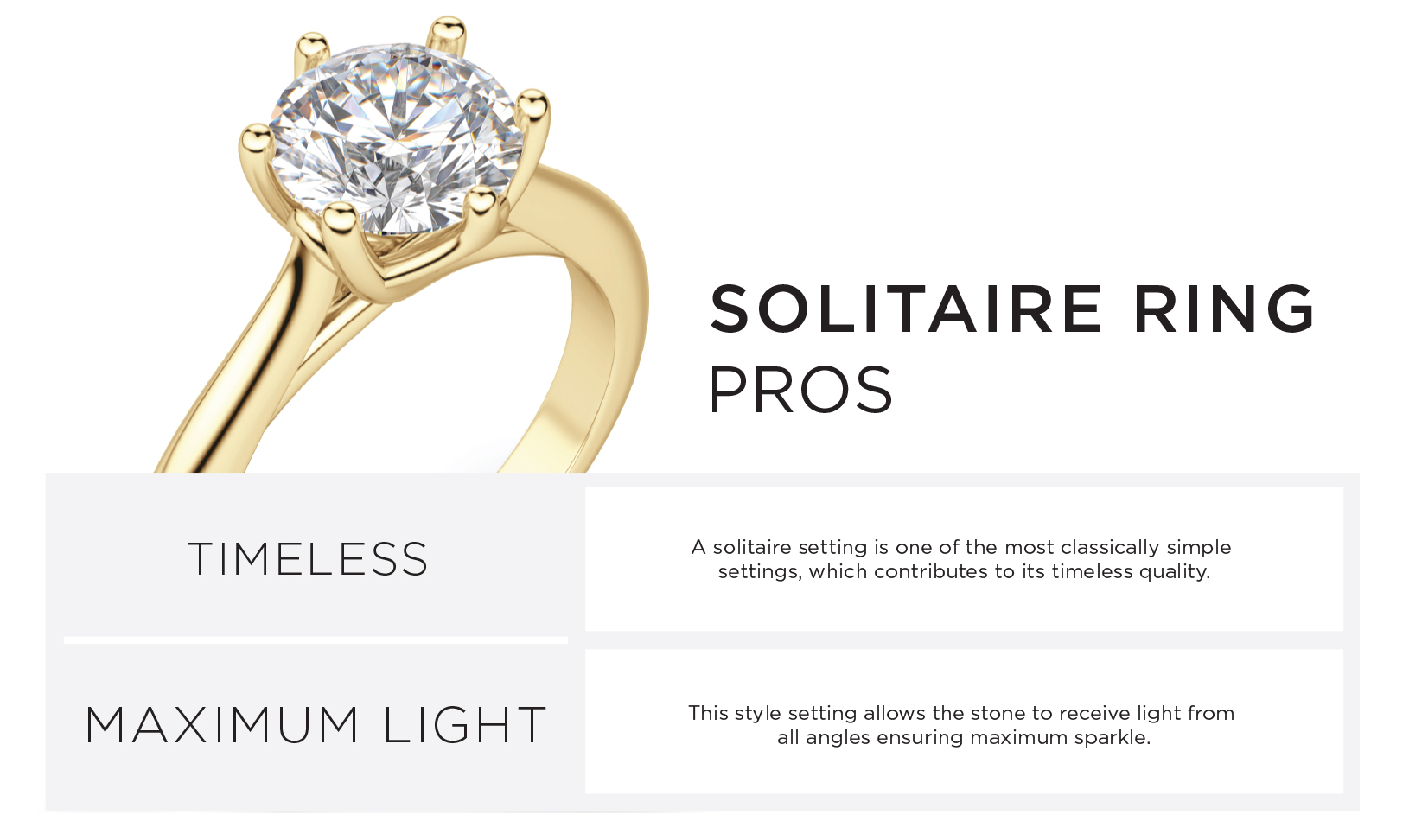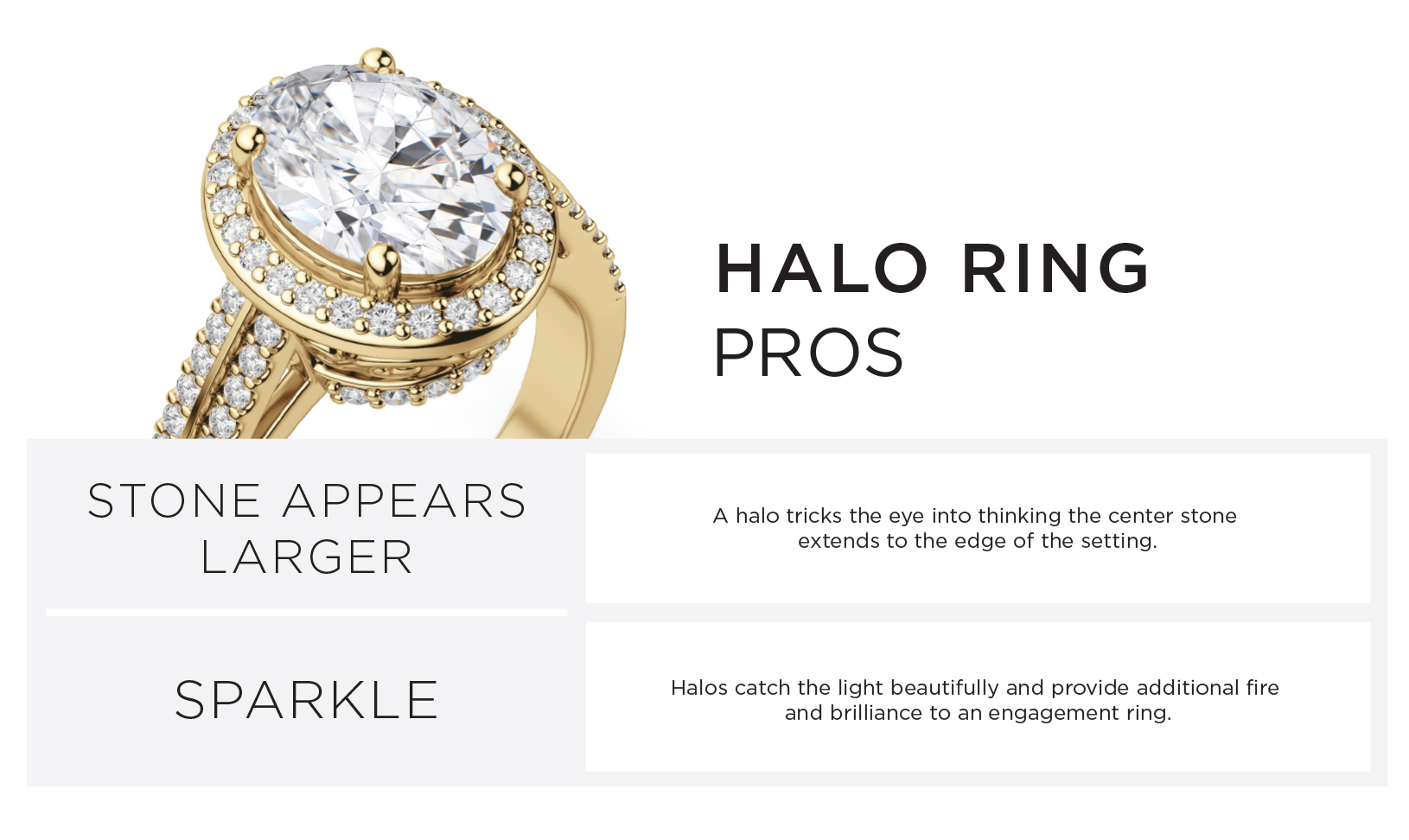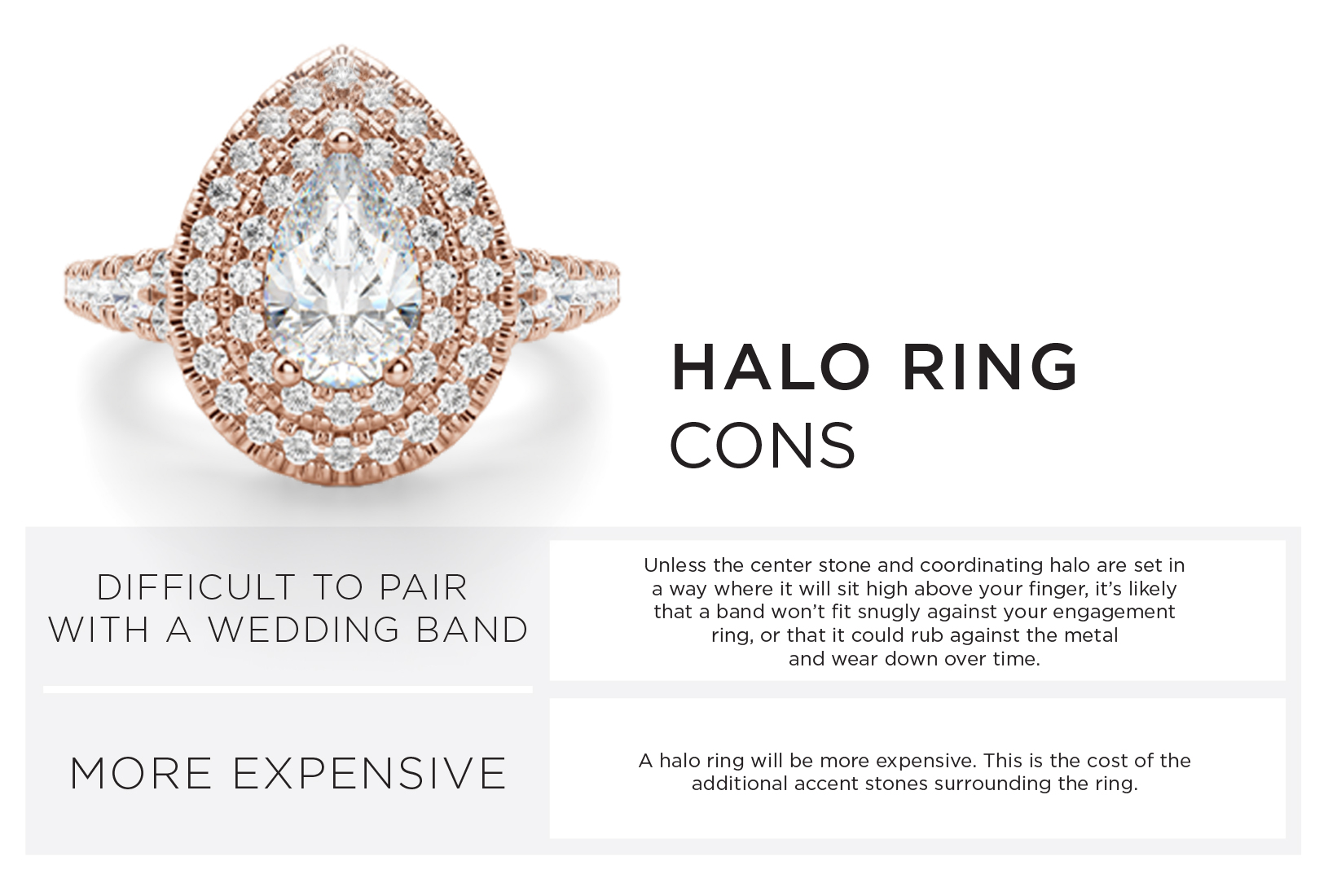Halo vs. Solitaire Engagement Ring Settings
October 15th, 2021 / Alese Oldenburg
While the cut of the stone or the color of metal seems to get the most attention, the setting can truly make all the difference in the look and feel of a diamond engagement ring. Presently, halo and solitaire are two of the most popular settings for engagement rings among brides. Between two stunning selections, though, how do you decide which one is right for you?
In this guide, we’ll walk you through a detailed comparison of halo vs. solitaire engagement rings. With all the knowledge of their differences and similarities, as well as the pros and cons of each one you can uncover which style setting best suits you.
What is a Solitaire Ring?

A solitaire ring is one in which the center stone is the main and only attraction. While the band can feature small diamonds, the setting is all about the single center stone. Not only can a modern center stone be a natural diamond, but it can also be a lab created diamond or a beautiful diamond alternative. There are multiple setting styles for a solitaire ring, but the most common options include prongs, which are the claws or beads of metal that wrap around the edges of the stone to keep it in place.
Pro: Timeless
A solitaire setting is one of the most classically simple settings, which contributes to its timeless quality. Whether you opt for a classic band in yellow gold or platinum, or a pave diamond band, there are no stylistic features that could go out of date when you choose a solitaire setting. Instead, it is solely about the center stone. However, that doesn’t leave you without a plethora of options to make it your own. Solitaire settings are just as versatile as they are timeless. All diamond cuts and even unique colored gemstones look fabulous in a solitaire setting, and the direction in which you set the stone is entirely up to you: North-South, East-West, or at an angle.

Con: The Stone Should Be Flawless
With a solitaire setting, there’s nothing to distract from the center diamond or stone. This is a pro if the center stone is big and beautiful, but it can be a con if the diamond has visible flaws or color because there is nothing for it to hide behind. If you would love a solitaire setting, but don’t have the budget for a flawless diamond, you may want to consider a diamond simulant. The Nexus Diamond™ alternative is a lab created diamond simulant that is virtually indistinguishable from a perfect diamond; it is internally flawless and colorless, ideal for a solitaire setting.
To learn how carat sizes of similar diamond cuts compare so you can select the right cut for your solitaire ring, view our diamond carat size chart. This chart displays the actual physical size of different diamond cuts at different carat weights so you can get the most value for your money.
Pro: Allows Maximum Light to the Center Stone
If you do have a flawless center stone, a solitaire setting is the best way to show it off. This style setting allows the stone to receive light from all angles ensuring maximum sparkle. For optimal brilliance, a prong solitaire setting is best as it will leave the sides of the diamond engagement ring exposed to light.

Con: Leaves the Center Stone Vulnerable
Because the sides and edges of the stone, where it’s most likely to come into contact with surfaces, are exposed in a solitaire setting, this style setting leaves the stone vulnerable to the most damage.
However, there are a couple of proactive steps you can take to protect your stone if you do opt for a solitaire ring. First, choose a secure setting such as a bezel setting or one with prongs; if you choose a stone cut such as emerald or princess, ensure the prongs cover the corners of the stone. Secondly, remove your ring when you’re working out, scrubbing surfaces, etc., to keep it from coming into contact with potential damage.
What is a Halo Ring?

A halo ring is one in which the center stone is surrounded by smaller stones on all sides, creating a halo effect. A “halo” is most commonly made up of small pave-style round cut diamonds but can be made up of any type of stone, in any color, and the stones can also be cut in any fashion. Vintage rings often featured colored gemstone halos and halos arranged in a pattern that created a semblance of a flower. This beautiful feminine style has had a resurgence of popularity in recent years. Halos can surround any cut of center stone as well, be it round, emerald, cushion, or pear. Also, see our article on what is a hidden halo ring.
Pro: Sparkle
One of the most noticeable effects of a halo setting is the sparkle it adds to any ring. Because halos are typically made of round cut or cushion cut diamonds, they catch the light beautifully and provide additional fire and brilliance to an engagement ring. This added sparkle and drama is what has made halo engagement rings popular for centuries. It has also led jewelers to design double halos, triple halos, or even more halos where multiple rows of smaller stones are stacked on top of one another. The more halos, the larger the size of the overall ring as well.

Con: Difficult to Pair with a Wedding Band
If you have your heart set on a certain wedding band, you may want to think twice before choosing a halo setting for your engagement ring. Unless the center stone and coordinating halo are set in a way where it will sit high above your finger, it’s likely that a band won’t fit snugly against your engagement ring, or that it could rub against the metal and wear down over time. You can avoid this potential struggle by having a wedding band custom fit to your engagement ring or selecting a high-set halo ring.
Pro: Makes the Center Stone Appear Larger
Another incredible benefit of adding a halo to your engagement ring setting is that it will make the center stone appear larger. A halo tricks the eye into thinking the center stone extends to the edge of the setting. If you’re on a budget, but still want the appearance of a big, flashy engagement ring, a halo can help you achieve the look. This effect is most pronounced when the stones that make up the halo are the same cut and color the center stone they surround.
A hidden halo engagement ring achieves this expertly. A hidden halo is a halo that is set slightly below the center stone. When viewed from above, the halo appears as a beautiful, sparkling extension of the center stone. Take this stunning halo round cut engagement ring, for example.

Con: More Expensive than Simpler Settings
While a halo setting can enhance the appearance of the center stone, it does come at a cost. Relative to simpler rings with the same size center stone, a halo ring will be more expensive. This is, of course, the cost of the additional accent stones surrounding the ring. Similarly, while any style band can complement a solitaire setting, a halo setting is often best paired with a pave band that continues the look of the setting all the way around, which also will add to the cost.
Halo Ring vs Solitaire: How To Choose
As with any engagement ring style, the best one is the one that suits the specific bride. Both halo and solitaire engagement rings have decorated millions of brides, celebrities and royals included, and both a halo engagement ring and a solitaire engagement ring are exquisite options. So then, the choice is entirely up to you.

We hope that learning the pros and cons of a halo vs. solitaire setting has helped you decide which style you most prefer. Ask yourself which ring setting best suits your style and needs. Do you prefer an elegant, timeless style or sparkly and glamorous? Does your budget allow you to purchase a flawless center stone worthy of a solitaire setting, or would a classic halo or perhaps a double halo provide the brilliance you’re looking for within your price range?
If you haven’t yet made up your mind, exploring different solitaire engagement rings and halo engagement rings may sway you in one way or another. You can narrow down your search even further by stone shape and color, as well as metal type, price, and even style. With an array of beautiful options, you’ll surely find one that speaks to you and can rest easy knowing you can’t choose wrong.
Sources:
*Here at Diamond Nexus, we strive to provide valuable information while being clear and honest about our products. The Nexus Diamond™ alternative is a patented lab created diamond simulant that, among all simulants, most closely imitates the look, weight and wear of a diamond, with two exceptions – it is absolutely perfect in every way, and it costs significantly less. Price points and environmental facts expressed in this blog were taken from popular online retailers and may vary. Learn more about the environmental impact of mining by visiting our blog.

